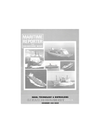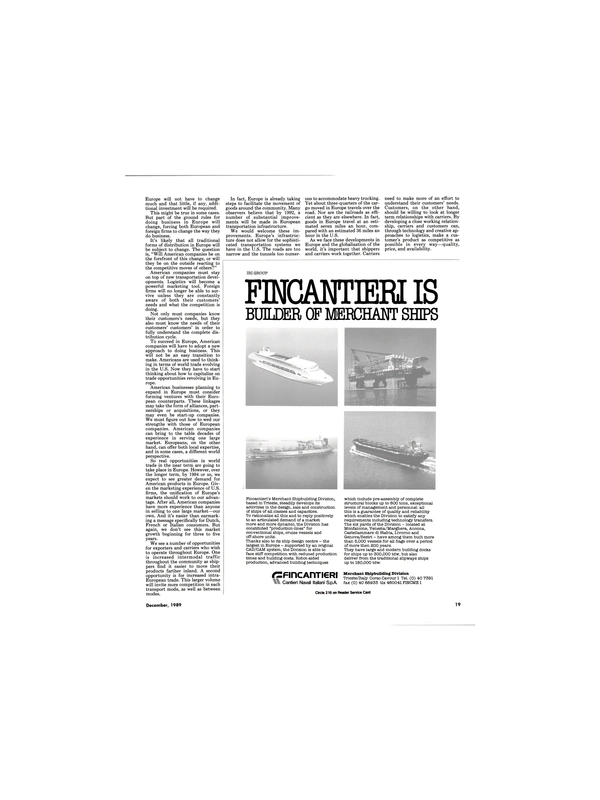
THE SHORT CRUISE MARKET IH EUROPE AHD HORTH AMERICA
The U.S. one-day market is one of the fastest growing segments of the North American cruise industry; the Baltic luxury ferry market is one of the most well-developed cruise markets in Europe. Why do Scandinavians purchase 27 times more short cruises per person than North Americans? How profitable are the two markets, and where is the money made? What product and service trends can be expected in the two markets? What lessons can the markets learn from each other?
Temple, Barker & Sloane, Inc., an international general management consulting firm, reported results of research and analysis it performed to answer these questions in the keynote speech of the Cruise & Ferry 89 conference held recently in London.
The research consisted of surveys of representative North American and Baltic cruise and ferry lines, industry interviews, as well as Temple, Barker & Sloane's studies of the U.S. one-day market and analysis of its worldwide cruise database.
U.S. One-Day Cruise & Baltic Luxury Ferry Markets While the two markets have roughly the same number of ships, in 1988 the Baltic luxury ferry market (13 ships and 6.8 million passengers) carried over 5 times the number of passengers as the U.S.
one-day market (with 9 ships and 1.3 million passengers).
Both markets have experienced steady growth in recent years. From 1985 to 1988, the Baltic luxury ferry market grew 4.4 percent annually while the U.S. one-day market experienced an explosive 20 percent annual growth.
The U.S. one-day cruise industry acts as an important source of new passengers for the overall U.S.
cruise industry because one-day cruises offer an attractive way for first-time cruisers to try the cruise experience without having to spend an extended period of time on board. About one-third of one-day cruisers eventually go on to purchase conventional cruises.
U.S. one-day cruise ports have tended to be located in vacation destinations which offer a yearround cruising season (e.g.-Miami, Ft. Lauderdale, Port Everglades, San Diego, etc.). Almost all one-day cruises begin and end in the same port. Baltic luxury ferries, on the other hand, usually act as a transportation link between major Baltic cities (e.g., Stockholm, Helsinki) or between ports which represent the shortest distance between key land masses (e.g.-Turku, Mariehamn).
Typical Ship & Product Characteristics Most Baltic luxury ferries are considerably larger than U.S. oneday cruise ships. The typical Baltic ferry has 27,000-30,000 grt and carries 1,800-2,000 passengers. The typical one-day cruise ship in the U.S., on the other hand, has 7,000- 10,000 grt and carries 900-1,000 passengers.
Much of the difference in ship size is due to the fact that Baltic luxury ferries carry passengers, cars, and trucks, while U.S. one-day cruise ships are dedicated to carrying passengers only. Baltic luxury ferries usually have enough cabins to accommodate approximately 80 percent of their passengers. The typical U.S. one-day cruise ship, which is substantially smaller and rarely offers overnight cruises, only has cabins for approximately 30 percent of its passengers. Some one-day cruise ships offer no cabins at all.
Typical Passenger Profiles U.S. one-day cruise lines and Baltic luxury ferries both attract mostly middle-aged cruisers who are repeat passengers, and both tend to have a younger passenger profile on weekends. While Baltic luxury ferries draw about 95 percent of their passengers from locals (Swedes and Finns) who live within 125 miles of the ports of departure, roughly half of the U.S. one-day cruisers are tourists to the area.
The higher percentage of tourists in the U.S. one-day market has led U.S. operators to use a wide range of media (e.g., local print, radio, television) and depend more on travel agents to obtain bookings. About half of U.S. one-day bookings are made through travel agents. In the Baltic, where almost all passengers are "locals," most tickets are sold directly by the ferry companies which use local print and signage to promote trips.
Trends & Implications The potential for considerable growth still exists in the U.S. oneday cruise market. Less restrictive gaming legislation is currently under discussion in several states. If this legislation is passed, the prospects of high on-board gaming revenues may encourage new cruise lines to enter the one-day market. TBS also believes that new one-day operations are likely to be developed in the near future on the Mississippi River and in new coastal locations.
There are a variety of important issues which currently face U.S.
one-day cruise lines: (1) new competitors can easily and inexpensively enter the market; (2) state regulations concerning gaming, a critical source of revenues, are constantly under review; (3) the potential surplus of 7-day cruise ships may begin to enter the market; (4) port facilities may become severely strained or limited in key locations; and (5) the aging population is becoming increasingly quality conscious and is demanding higher levels of service.
Competition will become more intense in the Baltic luxury ferry industry as new lines enter the market, and as newer, larger vessels are built. Ferry lines will be forced to increase promotional efforts to stimulate sufficient demand to keep new ships profitable. Baltic operators are also beginning to consider what effects, if any, EEC 1992 will have on their dynamic industry.
Suggested Steps For Action Actions that U.S. one-day operators should consider to attract more passengers include: (1) building new ships designed specifically for the one-day market instead of refurbishing older vessels originally designed for other markets; (2) developing new home ports and itineraries; (3) including one-day cruises in travel packages; and (4) improving menus and dining facilities. To increase on-board revenues, U.S. oneday operators should consider unbundling meals, requiring a surcharge for gourmet dining, improving shops, and gaming facilities, providing more cabins, and offering health spas.
Actions that Baltic luxury ferry operators should consider to attract more passengers include: (1) including ferry passages into more travel packages; (2) selling more ferry trips to groups outside Sweden and Finland; and (3) evaluating the market for "cruises to nowhere." To increase on-board revenues, Baltic luxury ferry operators should consider providing more boutiques, improving cabin quality, offering health spas, and adding to the onboard gaming facilities.
Summary A final comparison of these two dynamic markets underscores their potential for increased growth and profitability: •If 13.3 million Scandinavians purchased 6.8 million passages on Baltic luxury ferries, how much additional volume could be generated in the U.S. market from the 69 million coastal metropolitan residents who are currently buying only 1.3 million one-day cruises?
•If 1.1 million U.S. one-day cruisers spend $40 person in on-board casinos, how much additional gaming revenue could be generated in the Baltic market from the 6.8 million Scandinavians who are currently spending only $5 per person on gaming?
TBS believes that substantial growth opportunities exist in both the U.S. one-day cruise market and the Baltic luxury ferry market. Successful operators will be those that concentrate on providing passengers with a superior cruise experience and offering them a variety of attractive opportunities to purchase on-board goods and services.
This article summarizes a keynote speech presented by Dr. Stanley I. Buchin at Cruise & Ferry 89 conference held in London on May 24-25, 1989. Copies of the speech can be obtained by writing to Dr.
Buchin at Temple, Barker & Sloane, Inc., 99 Hayden Avenue, Lexington, Mass. 02173.
ABOUT THE AUTHORS Dr. Stanley I. Buchin is a senior vice president of Temple, Barker & Sloane, Inc., an international general management consulting firm based in Lexington, Mass. Dr.
Buchin heads the firm's Travel and Entertainment Group which assists cruise lines, hotels, resorts, casinos, and entertainment companies address a wide range of issues including strategic planning, marketing, and new product development. Dr. Buchin was formerly an Associate Professor of business administration at Harvard University, and holds a B.A. from the Massachusetts Institute of Technology, and MBA and DBA degrees from the Harvard Graduate School of Business Administration.
J. Duncan McDougall, an Associate in Temple, Barker & Shane's Travel & Entertainment Group, has provided management counsel to clients in the cruise, hotel, casino, spa, and tourism industries. Mr. McDougall formerly worked with travel companies in Alaska, Canada, and New Zealand. He holds a B.A. from Vanderbilt University and an MBA from the Amos Tuck School of Business Administration at Dartmouth College.
Read THE SHORT CRUISE MARKET IH EUROPE AHD HORTH AMERICA in Pdf, Flash or Html5 edition of December 1989 Maritime Reporter
Other stories from December 1989 issue
Content
- IMO Delaval Names Three New Managers For Turbine Division page: 8
- Manitowoc Engineering Names Fox Executive VP And General Manager page: 9
- Ocean Survey Ship, USNS Tanner, Launched By Beth-Sparrows Point page: 9
- Avondale Industries Christens N a v y ' s Newest Fleet Oiler, USNS Pecos ( T - A O - 1 9 7) page: 10
- Emergency Rescue Beacon Introduced By Litton To Aid Mariners In Distress page: 10
- Nine M A N B & W Holeby GenSets Ordered For Three Containerships To Be Built At Odense Shipyard page: 11
- MarAd Repair Subsidy Proposal Opposed By U.S. Shipbuilders page: 11
- WORLD SHIPBUILDING A MARKET POISED FOR RAPID TAKE-OFF AND SUSTAINED GROWTH page: 12
- U.S. YARDS COULD COMPETE WITH EUROPE IN 1990s* page: 14
- A SHIPBUILDER'S PERSPECTIVE page: 16
- THE SHORT CRUISE MARKET IH EUROPE AHD HORTH AMERICA page: 17
- EUROPE 1992: WHAT LIES AHEAD FOR U.S. COMPAHIES? page: 18
- OUTSTANDING OCEANGOING SHIPS OF 1989 page: 20
- A STATUS REPORT ON NAVY SHIPBUILDING AND REPAIR page: 27
- $23-Million Navy Contract Awarded Avondale To Enlarge Auxiliary Oiler page: 33
- U.S. Coast Guard Patrol Boats To Be Repowered W i t h Cat Engines page: 34
- Fincantieri Launches 'Scarabeo 5' Semisubmersible Drilling Rig page: 45
- Autronica Receives Order For Radar-Based Level Gaging Systems page: 47
- Cummins-Powered 'Grand Romance' Begins Excursion Service On St. Johns River In Florida page: 48
- Australian Admiral Test-Starts New Sub Engine At Hedemora Diesel—Literature Available page: 48
- W a r t s i l a Diesel Repowers Seattle Fishing Vessels page: 49
- MSI/CAORF Trains How To Avoid Ship Accidents Before They Happen page: 49
- Workboats Northwest Delivers Versatile 58-Foot Fishing Vessel page: 49


